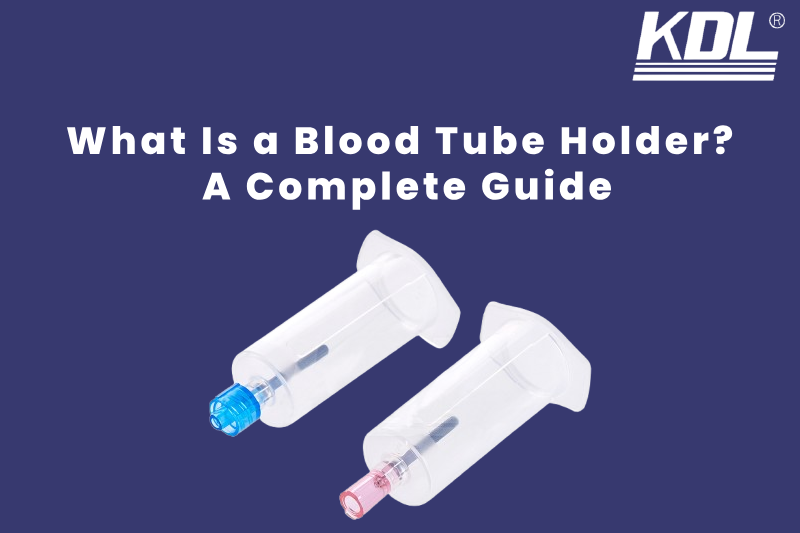
Accuracy and safety are particularly important in the fields of clinical diagnostics and phlebotomy. People know what syringes and tourniquets are, but there is a little yet important tool that many people don’t know about: the blood tube holder. This unsung hero is very important for drawing blood safely, quickly, and precisely.
If you are a medical student, lab technician, nurse, or clinic manager, knowing how to use the blood tube holder can help you make better choices, lower risks, and speed up your job.
This article will give you all you need to know about blood tube holders, including what they are, how they operate, safety guidelines, and where to get them.
What Is a Blood Tube Holder?
A blood tube holder, also called a vacutainer holder or needle holder, is a cylindrical plastic device used in blood collection. It acts as the connector between the vacutainer needle and the vacuum blood collection tube.
It serves two primary purposes:
- To hold the blood collection tube securely during venipuncture
- To maintain a sterile, controlled blood flow from the patient’s vein into the collection tube
Key Characteristics:
- Made from medical-grade plastic
- Available in disposable (single-use) or reusable formats
- Compatible with standard vacutainer needles and tubes
- Some models include safety mechanisms to prevent needle-stick injuries
Why Is a Blood Tube Holder Important?
The blood tube holder may seem like a modest gadget, but it offers big advantages for health care workers.
- Improves Efficiency: It lets you use one hand to do venipuncture and lets you quickly change tubes when you require more than one sample.
- Increases Safety: Safety-engineered disposable holders lessen the danger of needle-stick injuries and cross-contamination.
- Improves Precision: A strong, constant connection between the needle and tube keeps the vacuum pressure steady, which makes sure that samples are collected cleanly and without mistakes.
Types of Blood Tube Holders
Not all blood tube holders are the same, much as other medical instruments. Knowing the many kinds of blood tube holders can help you choose the best one for each job.
1. Standard Holders
The most popular and commonly used variety is the standard holder. They are usually composed of medical-grade plastic and built to hold one blood collection tube at a time. These are great for single-draw treatments or for utilizing butterfly needles. This is probably the first form of phlebotomy you’ll see if you’re just starting off.
For example, a basic holder used with a regular 21-gauge needle and a red-top tube to take blood.
2. Multi-Tube Holders
Need to take blood from one hole and put it into more than one tube? That’s where holders for Multi-Tube Holders come in. These holders are designed to let you replace tubes one after the other without taking the needle out of the vein. They are very helpful in hospitals and laboratories if you need to do more than one test from the same draw.
Multi-tube holders in phlebotomy make things easier, make patients more comfortable, and make things function better.
Holders that may be used more than once or thrown away
When choosing blood tube holders, this is a big selection point:
Disposable blood tube holders: Are designed to be used just once, which helps keep things from becoming mixed up. They are often utilized in outpatient clinics and during treatments that are quite risky.
Reusable blood tube holders: which are usually composed of stronger materials, may be sanitized and used several times. This makes them a good choice for bigger organizations that have sterilization processes in place.
When comparing blood tube holders, you typically have to weigh the cost, convenience, and necessity to manage infections.
How to Choose the Right Blood Tube Holder
1. Tube Compatibility
Size and Type of Tubes: Blood tube holders available in several sizes to suit tubes with diameters of 13mm, 16mm, or 21mm. Make sure that the holder works with the blood collection tubes you want to use (such Vacutainer, EDTA, or serum tubes).
Some holders are designed to carry particular tubes with specified characteristics, including safety covers or tubes with varying vacuums.
2. Material and Strength
High quality Blood tube holders are commonly composed of strong plastics like polypropylene or light metals like aluminum. People frequently choose polypropylene holders because they are light and resistant to chemicals.
Impact Resistance: It’s crucial for a holder to be built of a material that won’t fracture or shatter if it falls, particularly in busy medical settings.
3. Simple to use
Grip and Comfort: Look for holders that are designed to be comfortable for the healthcare practitioner to grasp. Some holders feature rubberized parts that make it easier to grasp and manipulate, which is important for drawing blood.
One-Handed Operation: Some holders are designed so that healthcare staff may load and remove tubes with only one hand. This makes blood collection faster and easier.
4. Features for safety
Needle Safety: Look for a blood tube holder that has a built-in safety feature to save people from being hurt by needle sticks. For example, a shielded holder or a design that lets you safely handle needles after blood collection.
Base that doesn’t slide: A holder with a base that doesn’t slip is helpful since it keeps the holder from sliding about while you’re using it, which makes it more stable.
5. Sterility and the ability to be used again
Choose blood tube holders that are either single-use or easy to clean and sterilize to keep things sterile. Some holders are designed for single use to reduce the possibility of contamination in places where cleanliness is very important.
Choose between a reusable holder that can be cleaned after each use or a disposable holder to keep things clean between patients.
7. Cost-Effectiveness
It’s crucial to get good equipment, but you need also think about the whole cost, particularly if you want to buy a lot of it. Make sure that the blood tube holder is worth the money, lasts a long time, and is safe.
KDL Premium Blood Tube Holder with Needle Assembly
At KDL we manufacture and supply high-quality blood tube holders designed for reliability, safety, and ease of use. Our holders are compatible with standard vacuum blood collection systems and built to reduce the risk of contamination and needle-stick injuries.
Why Choose Us?
- ISO-certified manufacturing
- Bulk supply available globally
- Trusted by hospitals, clinics, and labs
- Custom branding available on request
Final Thoughts
A blood tube holder might seem like a small tool, but it plays a big role in safe and effective blood collection. Whether you’re a patient curious about what’s happening during a blood draw, or someone starting out in healthcare, knowing how these tools work is a great first step.
By choosing the right type of holder — reusable, disposable, or safety-engineered — hospitals and clinics help protect patients and staff while keeping the process smooth and clean.
 +86-791-8686-1216
+86-791-8686-1216 

